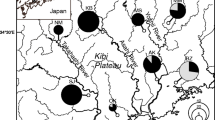Abstract
Cleavage patterns of mitochondrial DNA (mtDNA) by restriction endonucleases were examined in musk shrews collected at six trapping sites on two Japanese and two Indonesian islands, on Sri Lanka, situated close to the Indian subcontinent, and on the mainland of East Bengal in Bangladesh. No variation of mtDNAs was found among the Japanese and Indonesian shrews, despite their geographical isolation by the sea. In contrast, at least six mtDNA types were present in the Sri Lanka and the Bangladesh populations (three types for each), and these two populations seemed to be differentiated to the extent, which could be compared to the “mice-intersubspecific” differences. These populations were also differentiated from the Japanese-Indonesian type. Furthermore, a similar level of differentiation was also estimated between two mtDNA types within these respective populations. This feral species might be considered unique because of its high emigration rate caused by human movements and its high rate of subspecific hybridization.
Similar content being viewed by others
References
Ellerman, J. R. (1961).The Fauna of Indian including Pakistan, Burma and Ceyron Baptist Mission Press, Calcutta.
Ellerman, J. R., and Morisson-Scott, T. C. S. (1951).Checklist of Polaearctic and Indian Mammals, 1758 to 1946 British Museum, London.
Ferris, S. D., Sage, R. D., Huang, C.-M., Nielsen, J. T., Ritte, U., and Wilson, A. C. (1983). Flow of mitochondrial DNA across a species boundary.Proc. Natl. Acad. Sci. USA 802290.
Iseki, R., and Kondo, K. (1984a). Genetic variants found in plasma α-amylase and erythrocyte carbonic anhydrase in the musk shrew (Suncus murinus).Exp. Anim. 3391.
Iseki, R., and Kondo, K. (1984b). Genetic polymorphism of the vitamin D binding protein (Gc) in the musk shrew (Suncus murinus).Anim. Blood Grps. Biochem. Genet. 1555.
Iseki, R., Namikawa, T., and Kondo, K. (1984). Cream, a new coat-color mutant in the musk shrew.J. Hered. 75144.
Ishikawa, A., Tsubota, A., and Namikawa, T. (1987). Morphological and reproductive characteristics of the musk shrew (Suncus murinus) collected in Bangladesh, and development of laboratory line (BAN line) derived from them.Exp. Anim. 36253.
Ishikawa, A., Akadama, I., Namikawa, T., and Oda, S. (1989). Development of a laboratory line (SRI line) derived from the wild house musk shrew,Suncus murinus, indigenous to Sri Lanka.Exp. Anim. 38237.
Nei, M., and Li, W. H. (1979). Mathematical model for studing genetic variation in terms of restriction endonucleases.Proc. Natl. Acad. Sci. USA 765269.
Oda, S. (1978). Exotic and commensal mammal, the house musk shrewSuncus murinus in Japan.J. Biol. Nagasaki 151. (Japanese).
Tsubota, Y., and Namikawa, T. (1988). Alleles at plasma α-amylase locus (Amy-1) of the house musk shrew (Suncus murinus): Frequency distribution and new variants in laboratory lines and Asian population.Exp. Anim. 37159.
Tsubota, Y., Namikawa, T., Hasnsth, M. A., Mostafa, K. G., and Faruque, M. O. (1984). Morphology and breeding of the wild musk shrews (Suncus murinus) captured in Bangladesh. InGenetic Studies on Breed Differentiation of the Native Domestic Animals in Bangladesh Tokyo Univ. Agr., MICRO Printing Tokyo, p. 115.
Tsubota, Y., Namikawa, T., Nishida, T., Adachi, A., and Cyril, H. W. (1986). Morphology and reproduction of wild musk shrews,Suncus murinus, in Sri Lanka.Rep. Soc. Res. Native Livestock 11241 (Japanese).
Yamagata, T., Ishikawa, A., Tsubota, Y., Namikawa, T., and Hirai, A. (1987). Genetic differentiation between laboratory lines of the musk shrew (Suncus murinus, Insectivora) based on restriction endonuclease cleavage patterns of mitochondrial DNA.Biochem. Genet. 25429.
Yonekawa, H., Moriwaki, K., Gotoh, O., Hayashi, J. I., Watanabe, J., Miyashita, N., Petras, M. L., and Tagashira, Y. (1981). Evolutionary relationships among five subspecies ofMus musculus based on restriction enzyme cleavage patterns of mitochondrial DNA.Genetics 98801.
Yosida, T. H. (1982). Cytogenetical studies on Insectivora. II. Geographical variation of chromosomes in the house shrew,Suncus murinus (Soricidae), in East, Southeast and Southwest Asia, with a note on the Karyotype evolution and distribution.Jap. J. Genet. 57101.
Author information
Authors and Affiliations
Rights and permissions
About this article
Cite this article
Yamagata, T., Tanaka, Y., Ishikawa, A. et al. Genetic relationship among the musk shrews,Suncus murinus insectivora, inhabiting islands and the continent based on mitochondrial DNA types. Biochem Genet 28, 185–195 (1990). https://doi.org/10.1007/BF00561336
Received:
Revised:
Issue Date:
DOI: https://doi.org/10.1007/BF00561336




